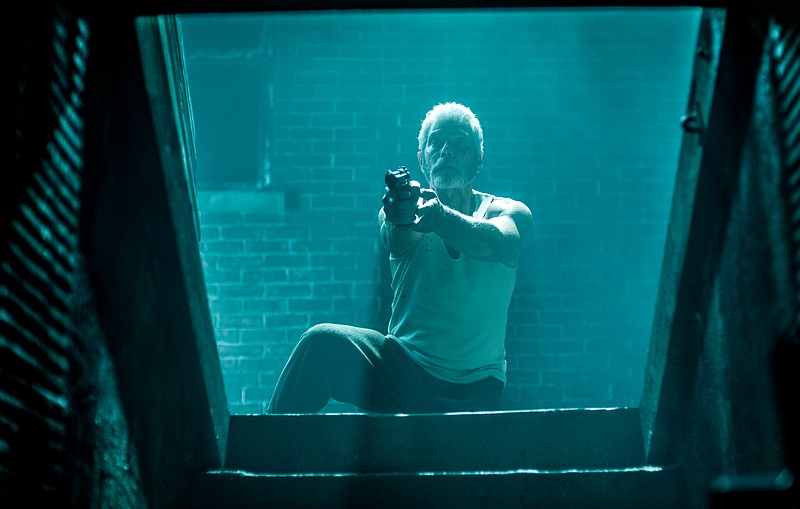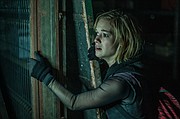Best scares
Here are some of the films that horror aficionados list among their favorites:* “Alien”* “Aliens”* “Evil Dead” (The trilogy)“A Nightmare on Elm Street”* “Halloween”* “The Thing” (1981 John Carpenter remake)* “The Haunting” (1963 original)* “The Texas Chainsaw Massacre (1974 original)* “The Descent”* “Fright Night” (1985 original)* “Carnival of Souls”* “Phantasm”* “The Exorcist”* “Arachnophobia”
Horror festival
Chattanooga Film Festival and Cine-Rama host their annual Frightening A— Film Festival series on Saturday, Oct. 29. An all-day wristband is $35, but individual films also have their own ticket price. For tickets to any of the movies, go to http://chattanooga-film-fest.myshopify.comHere are the films:* “Carnival of Souls,” new 4k restoration. 1 p.m. $7A young woman becomes haunted by a bizarre apparition that compels her toward an abandoned lakeside pavilion.* “Phantasm: Ravager.” 2:30 p.m. $10Fifth and final film in “Phantasm” series. Brothers Mike and Jody and friend Reggie are back and still battling the Tall Man, a supernatural undertaker from another dimension.* “Under the Shadow.” 4:15 p.m. $10In Tehran, a mother and daughter find their home haunted by a mysterious evil.* “Beyond the Gates,” with Director Jackson Stewart. 8:45 p.m. $10Two estranged brothers reunite seven months after their father’s disappearance to liquidate his video store. While there, they unearth an old VCR board game that acts as an inter-dimensional hub to a nightmare world where their father’s soul is trapped and can only be saved by playing the game.* “Found Footage 3D,” with Director Steven DeGennaro. 10:30 p.m. $10Filmmakers are making the first 3D found footage horror movie, but an evil entity put them in a horror movie.
A married couple tries to figure out odd goings-on in a house. It's worse than they thought.
A trio burglarizes a blind veteran's home. Man, that is one bad decision.
A mother has an imaginary friend and her daughter thinks it's mental illness. Yeah, not so much.
Three horror movies released this year, each grossing more than $100 million worldwide, the financial hurdle that signals a blockbuster - and each was made for chump change in the days when a single film's production costs can soar past seven figures.
"The Conjuring 2," made for $40 million, has brought in more than $320 million worldwide. "Don't Breathe," which cost $9.9 million to make, has returned almost $120 million. "Lights Out," put together for a paltry $4.9 million, has grossed more than $146 million.
These successes stand in contrast to some big-boomer movies that cost a ton of dough but came up short in ticket sales - frighteningly short in some cases.
Earning $86 million worldwide, the epic remake of "Ben-Hur" didn't even cover its $100 million production costs; Hollywood Reporter estimated that it may lose $120 million when advertising and distribution costs are figured in. Steven Spielberg's "BFG" made a total of $173 million worldwide, which topped its $140 million production costs but, again, add in its post-production costs and Hollywood Reporter figures it'll lose from $90 to $100 million.
The all-female remake of "Ghostbusters" would seem to be a hit, raking in $224 million worldwide, but with production costs of $144 million and $150 million in estimated advertising and distribution costs, it's falling short by about $74 million.
So the arterial-red writing is splattered all over the wall: You don't have to spend a lot of cash to make an effective horror film that rakes in the dollars.
"You can make 100 'Conjurings' for the cost of one 'Captain America,'" says Chris Dortch, founder of Cine-Rama and Chattanooga Film Festival and a self-described lover of horror films. Such under-the-radar movies attract an audience that wants "thoughtful, well-put-together horror films," he says.
Smaller, cheaper-to-make horror movies can be "character-driven and sometimes plot-driven films and the opposite of these big-budget special-effects films," says Eric Niemi, a horror fan with a doctorate of education who teaches English at Chattanooga State Community College.
Horror doesn't need bone-shattering explosions to capture the attention, he says, nor does it need heart-racing action scenes to get the heart pumping. In fact, when it comes to horror, subtlety can be a better tool than being loud and in your face, says Niemi, who lists "Arachnophobia" and the original "Night of the Living Dead" as a couple of his favorites.
New directors such as James Wan ("Conjuring," "Conjuring 2," "Insidious") and Mike Flanagan ("Oculus," "Before I Wake," the upcoming "Ouija: Origin of Evil") understand that slow-burn terror ratchets up the fear, making the Boo! moments even more effective.
"Every 10 to 15 years a new generation of filmmakers is coming through and horror movies are fairly easy to put together, " Niemi says. "It's a way to test their skills."
Shellina Blevins, though, has a simpler explanation for the success of horror this year.
"Because they aren't full of zombies," she says. "Now, granted, we all love a zombie, but if you get pizza all the time, at some point you are going to want a burrito or two. Hollywood has a tendency to harp on one idea until it's nothing more than a dried-up husk of its former self."
Much of that zombie love springs from the super-success of TV's "The Walking Dead" which, in a tried-and-true Hollywood fashion, spun off a graveyard full of cheap, derivative and lousy zombiefests.
Moneymaking horror films can be both a resurrection and temporary stake to the heart of the genre. Imitation may be a sincere form of flattery, but cash not compliments led from the successes of 1931's "Frankenstein" and 1935's "Bride of Frankenstein" to the lowbrow joke of 1943's "Abbott and Costello Meet Frankenstein." And the trend has never stopped.
"Studios see a bunch of horror films making money and they take all the properties they have in the vault and dump them out," Dortch says. For the studios, "it's kind of a Groundhog Day test."
"If this movie comes out and the sun is shining and an audience comes, it determines what comes out the rest of the year," he says.
And yeah, some of these films are truly wretched, but the inevitable glut of seen-that-before films is "not indicative of horror movies, that's indicative of Hollywood," says Red Bank High School graduate Kellen Potts, whose fandom runs so deep, he wrote a thesis on the genre while a senior at Binghamton University in New York.
In many cases, "horror thinks outside the box a lot," Blevins says. "You can get some very creative story lines sometimes."
Dortch notes that the genre - in film, books and other entertainment forms - "in general gets a bad rap," often tagged as the land of bloodthirsty teen and young adult males who think "Beavis & Butthead" is high art. But there are many types of horror - supernatural, slasher, psychological, Japanese, to name a few - offering something for everyone, he says. And, despite the stereotypical view, not all films are "drenched in gore," he says, although there's a place for those films, too.
"People who might be fans of classic, great ghost stories aren't the ones who are going to like the new 'Saw movie," says Dortch, who lists "A Nightmare on Elm Street" and its razor-gloved villain Freddie Krueger as one of his most terrifying moments as a kid.
"After seeing it, I padded the crack between my bed and the wall so Freddie couldn't reach up to get me," he says.
Communal contact
But even in badness, horror films can touch a nerve, especially in a theater, where a horror movie becomes a communal event, a blending of souls, so to speak. "People love to see them with an audience," Dortch says.
Fans of these films "really want to go see these and get the traditional movie experience. They don't translate real well to the home audience," says Niemi.
For Blevins, who has a tattoo of a chainsaw to show love for the "Evil Dead" trilogy of movies, the attraction of horror movies is "the high you get from a good scare, especially shared with friends."
As anyone who's seen a scary film in a theater can attest, right after a scene that makes viewers cringe or scream, there's usually a burst of laughter from the audience, "a letting off of tension," says Potts.
If Blevins' one tattoo is a sign of affection, Potts is a walking skin poster for horror. He has a tattoo representing Stephen King's "Dark Tower" series, one of actress Kathy Bates as Annie Wilkes in the film for King's "Misery" and, like Blevins, another celebrating the film "Evil Dead." And those aren't the only tattoos he has; his level of body ink stands in contrast to his job as a criminal defense attorney in Albany, N.Y.
And, as you might guess, Potts defended horror movies in his senior thesis.
"Usually they're kind of put down upon; they're not seen as well-made or high art," the 30-year-old says. "But I think they are art and they have a beneficial impact on society."
Such films appeal to a base, primitive side of humans, he explains, allowing us to release instincts that normally are strangled.
"Human beings are animals with a will to hunt, yet we are controlled by society so we stuff that down," he says. "Horror movies give a way to exercise those animal instincts vicariously."
They also allow us to confront our fears and to comment on society's rules without being heavy-handed in delivering the message, he says.
"Too often movies try to have a message and people feel like they're being preached to, so they shut down," Potts says. While horror movies address serious concerns, they don't come off as preachy, he adds.
"It Follows" from 2014 is "a clearcut allegory on rampant causal sex and STDs and the consequences of such," both he and Niemi say. "Night of the Living Dead" is a metaphor for the aftermath of nuclear war while 1978's "Dawn of the Dead" - both films were directed by George Romero - is a commentary on consumerism, taking place in a shopping mall where zombies shuffle along like blind, sale-hungry shoppers.
Even "Frankenstein" was a reaction to the horrors of World War I in which new biological weapons such as mustard gas were deployed, creating "monsters" out of soldiers exposed to it. The original novel, "Frankenstein; or, The Modern Prometheus," written by Mary Shelley and published in 1818, presented the theme that humans were moving too quickly in the development of science and taking creation away from God.
Horror connoisseurs will see "those subtextual moments coming" and eagerly anticipate them, Dortch says.
"Horror is a great topic for intelligent filmmakers to smuggle in great ideas," he says.
Contact Shawn Ryan at sryan@timesfreepress.com or 423-757-6327.

